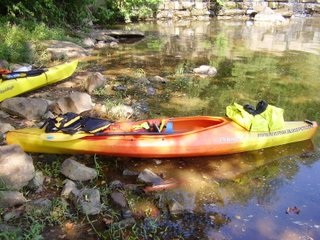by Amber Ellis, JRA's Watershed Restoration Associate/Volunteer Coordinator
The People
JRA’s Watershed Restoration “team” is made up of only two
people who cover the entire watershed!
 Michelle Kokolis is the Watershed Restoration Program
Manager and has been with JRA since 2008. She grew up just north of Pittsburgh
near the Allegheny River and if you have ever met her, you will know she is a
huge Pittsburgh Steelers fan! Michelle received a Masters of Science in Biology
with a concentration in Wetland Sciences from Old Dominion University. One
reason our staff love her? She can make one mean cupcake!
Michelle Kokolis is the Watershed Restoration Program
Manager and has been with JRA since 2008. She grew up just north of Pittsburgh
near the Allegheny River and if you have ever met her, you will know she is a
huge Pittsburgh Steelers fan! Michelle received a Masters of Science in Biology
with a concentration in Wetland Sciences from Old Dominion University. One
reason our staff love her? She can make one mean cupcake! Amber Ellis splits her time between Watershed Restoration
and Volunteer Coordination for all programs and has been with JRA since May
2010. Amber grew up in Powhatan County and has a healthy obsession with
gardening. She may be the only person that actually enjoys weeding! Amber
received a Bachelors of Landscape Architecture from Virginia Tech and is a
licensed Landscape Architect in Virginia.
Amber Ellis splits her time between Watershed Restoration
and Volunteer Coordination for all programs and has been with JRA since May
2010. Amber grew up in Powhatan County and has a healthy obsession with
gardening. She may be the only person that actually enjoys weeding! Amber
received a Bachelors of Landscape Architecture from Virginia Tech and is a
licensed Landscape Architect in Virginia.
The Work
People may think that we are outside every day planting
trees., but about 75% of our time is spent in the office. While our projects
evolve constantly, there are a few things that remain constant: engaging the
public through hands-on projects and educating the public on watershed health.
Our volunteer events include cleanups,
rain garden maintenance, and planting. The Self-Directed Trash Program allows
groups to direct their own cleanup with site ideas and supplies provided by us.
Extreme Stream Makeover is a major project that we do every couple years within the James
River watershed. This is a weeklong restoration project that targets an
impacted urban stream. During that intensive week volunteers remove trash, build
rain barrels, plant buffers and install rain gardens in the targeted area.
Corporate partner often want to conduct a team building or
community service event and with their support, we are able to provide an event
catered toward their needs. Some examples have included an invasive species
removal and bluebell planting at Pony Pasture with the employees of Tredegar
and a tree planting at Bryan Park with Altria staff.
Our education efforts include rain barrel workshops, presentations
to groups, and the River Hero Homes certification program. This program recognizes
homeowners who are taking steps to improve water quality on their property. Some steps they can take include installing a
rain barrel, cleaning up after their pet, or planting natives.
There are many ways for you to become involved with JRA’s
Watershed Restoration efforts. Sign up to volunteer today for one of our upcoming events,
rain barrel workshops, or become a River
Hero Home!












